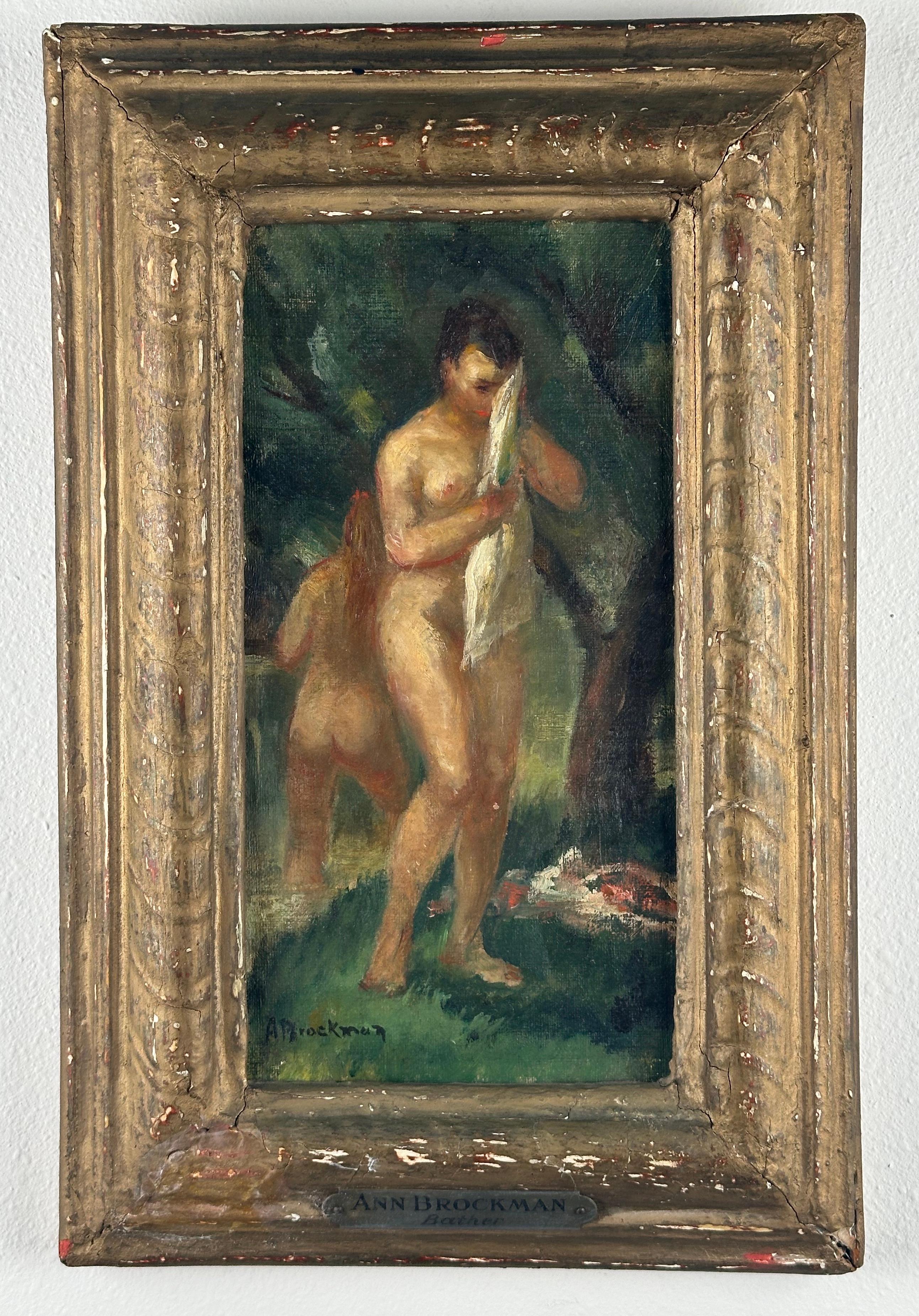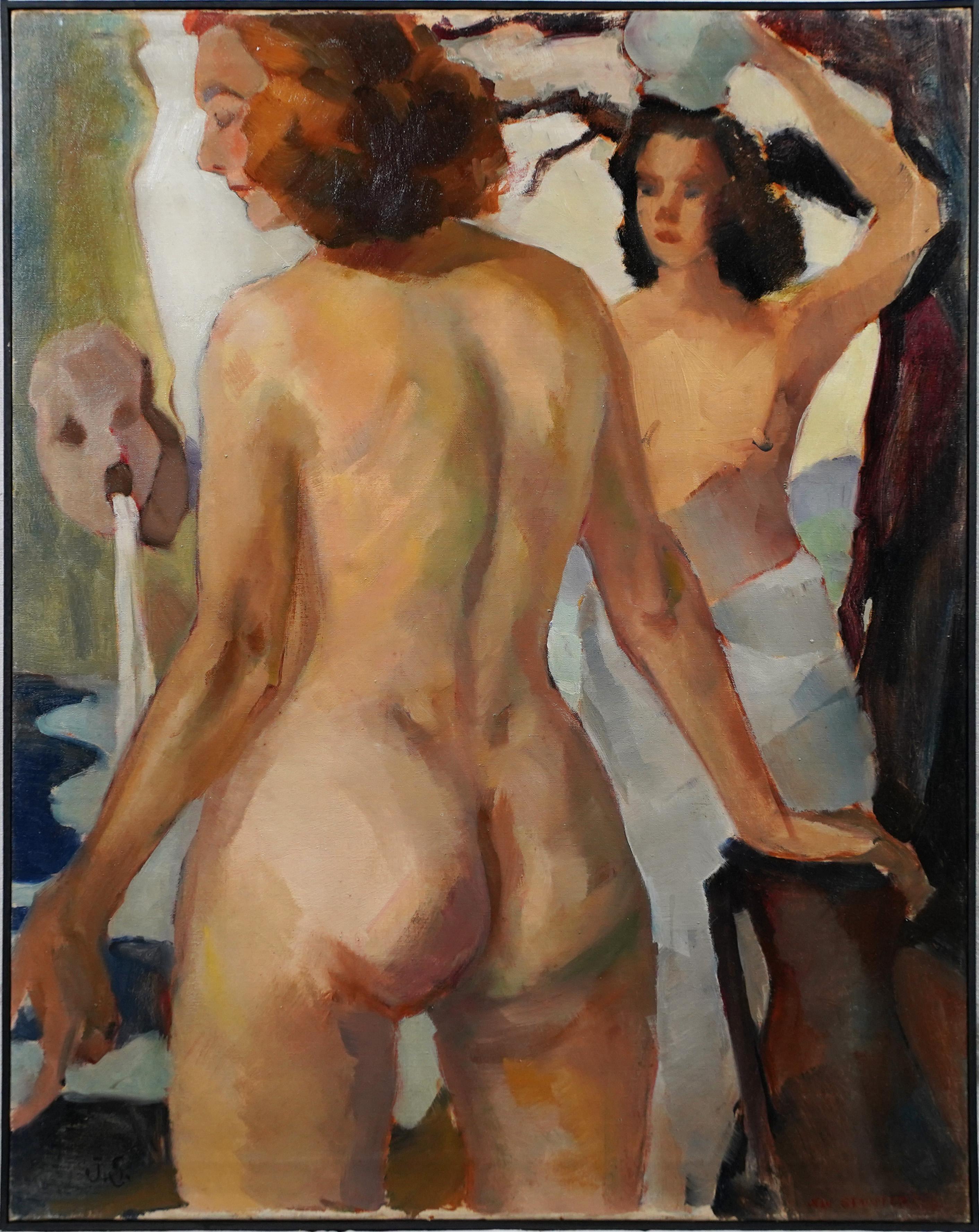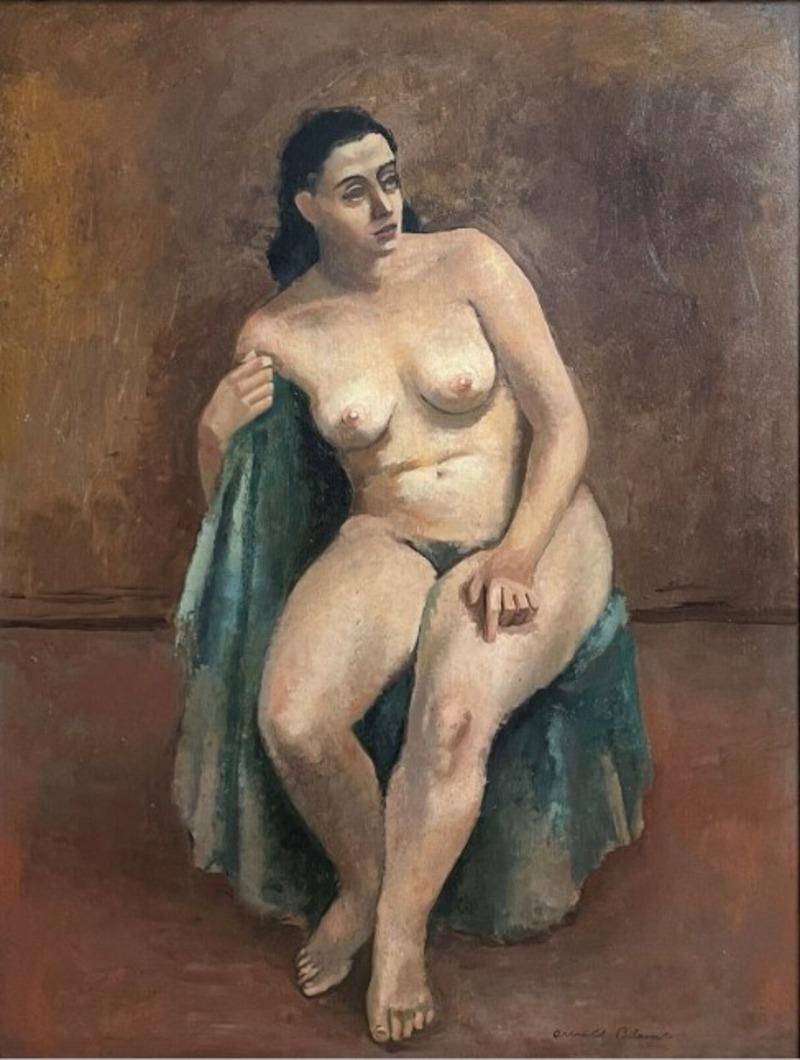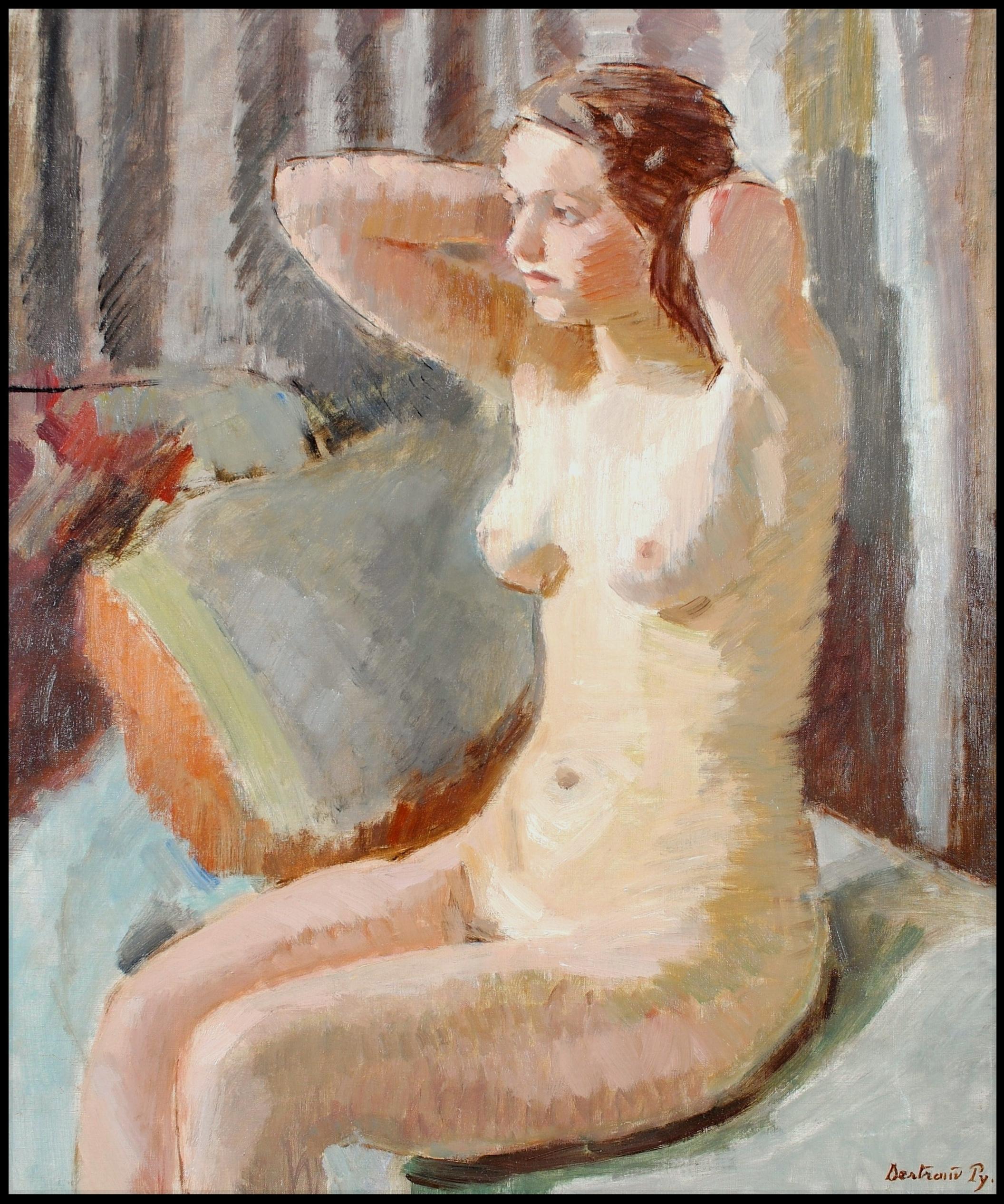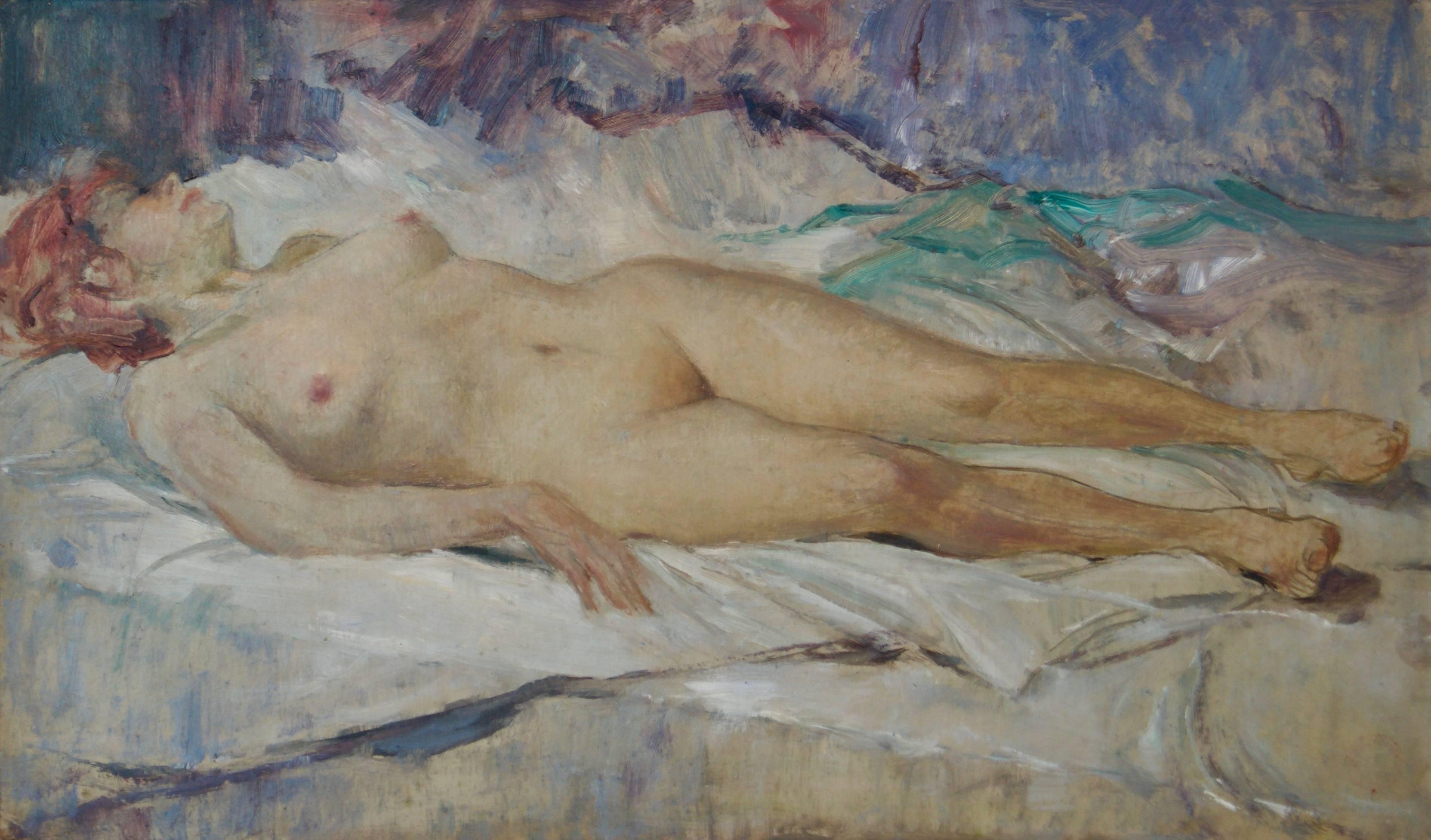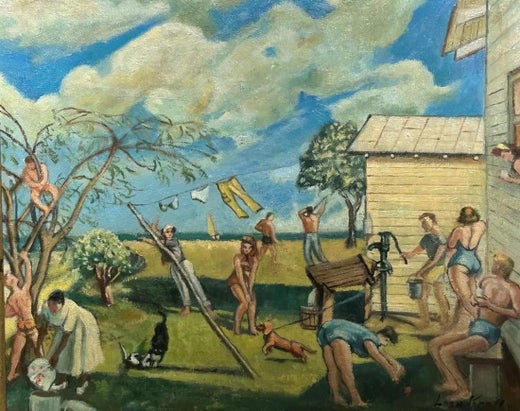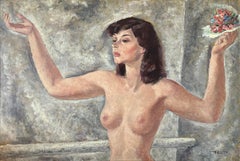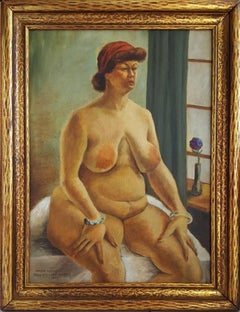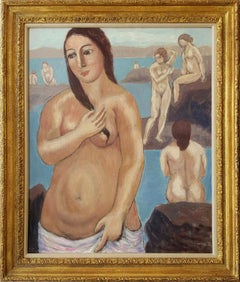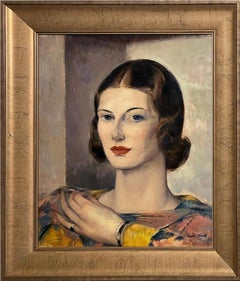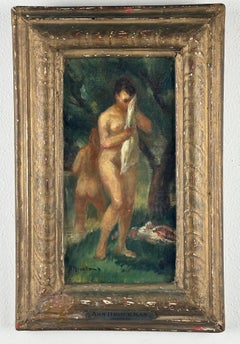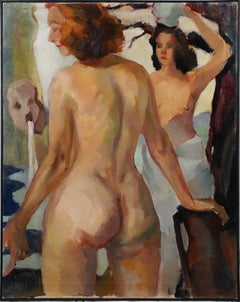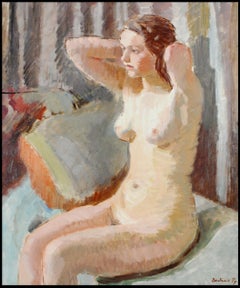Items Similar to Timeless and Classic Nude Girl at Pool - Academic Artist
Video Loading
Want more images or videos?
Request additional images or videos from the seller
1 of 14
Leon KrollTimeless and Classic Nude Girl at Pool - Academic Artist1935 circa
1935 circa
$28,000
£21,245.76
€24,292.62
CA$39,108.41
A$43,483.23
CHF 22,704.54
MX$529,296.77
NOK 289,700.07
SEK 271,435.13
DKK 181,300.31
Shipping
Retrieving quote...The 1stDibs Promise:
Authenticity Guarantee,
Money-Back Guarantee,
24-Hour Cancellation
About the Item
This painting of a classic nude at a pool, "Hilda at the Pool," is both a portrait and a landscape. Leon Kroll rejected Modernism to triumph in the beauty of Classicism.
During his lifetime, Leon Kroll was one of the USA's most productive and successful artists of the 20th century. He is a classicist, and his portraits and landscapes are based on observation and knowledge. Kroll's work gets better the closer the viewer gets to the canvas, so that one can marvel at his simultaneous
understated yet complex painting technique. Kroll makes it look so easy.
Signed lower right
The Video is coming up light. Refer to the still images for more accurate color.
The painting will look best with a top gallery style lighting to bring out color and detail. The painting is best viewed with top gallery like lighting.
Lined canvas. Under UV exam, 4 inch vertical line of inpaint along the right edge of the figures leg, and a few scattered dots and dashes of inpaint; most notable in the figure's right thigh. Small 1/4 inch dot of in paint in the cheek, and a few spots in the extreme upper right corner. Minor areas of thinning to paint layer in figure's arms and torso. Yellowed varnish. Faint 1 inch scratch in near the figure's jaw.
Framed Dimensions 45 X 29.25 Inches
Kroll was born in New York and studied at the Art Students League under John Twachtman and at the National Academy of Design. Between 1908 and 1910, Kroll studied in Paris at the Académie Julian; during these years, Kroll discovered Paul Cézanne, the influences of whom are readily apparent in early works. Upon returning to America, Kroll's work was exhibited in 1913 at the Amory Show. By the 1920s he had begun teaching, at the National Academy of Design and at the Art Institute of Chicago.
During the 1930s Leon Kroll and his wife Geneviève (whom he had met in France) began spending time in Gloucester's Folly Cove neighborhood, not far from the Babson Farm Quarry (known today as Halibut Point). In 1944 they purchased a property there, and for the rest of their lives divided their time between Cape Ann and New York. The Krolls and their daughter, Marie-Claude, quickly formed friendships with many of the other artists living and working in the area including Paul Manship, Walker Hancock, Virginia Lee Burton Demetrios and George Demetrios."
- Creator:Leon Kroll (1884-1975, American)
- Creation Year:1935 circa
- Dimensions:Height: 42 in (106.68 cm)Width: 26 in (66.04 cm)
- Medium:
- Movement & Style:
- Period:
- Condition:Lined canvas. Under UV exam, 4 inch vertical line of inpaint along the right edge of the figures leg, and a few scattered dots and dashes of inpaint; most notable in figure's right thigh. Small 1/4 inch dot of in paint in the cheek, and a few spots.
- Gallery Location:Miami, FL
- Reference Number:1stDibs: LU385314554222
Leon Kroll
Leon Kroll (1884-1974) was one of this country’s most productive and successful artists of the 20th century. A well-regarded teacher and the recipient of numerous awards and recognitions during his life time. Kroll was born in New York City and studied at the Art Students League under John Twatchman and at the National Academy of Design. Between 1908 and 1910, Kroll studied in Paris at the Académie Julian; during these years, Kroll discovered Paul Cezanne, the influences of whom are readily apparent his work. Upon returning to America, Kroll’s work was exhibited in 1913 at the Amory Show. By the 1920s he had begun teaching, at the National Academy of Design and at the Art Institute of Chicago.
During the 1930s, Leon Kroll and his wife Genevieve (whom he had met in France) began spending time in Gloucester’s Folly Cove neighborhood, not far from the Babson Farm Quarry (known today as Halibut Point). He became a central figure in Cape Ann’s summer art colony for many years. Kroll is represented in the permanent collections at the Corcoran Gallery of Art; PAFA; Metropolitan Museum of Art; Museum of Modern Art; Art Institute of Chicago; Los Angeles County Museum of Art; Dayton and many more.
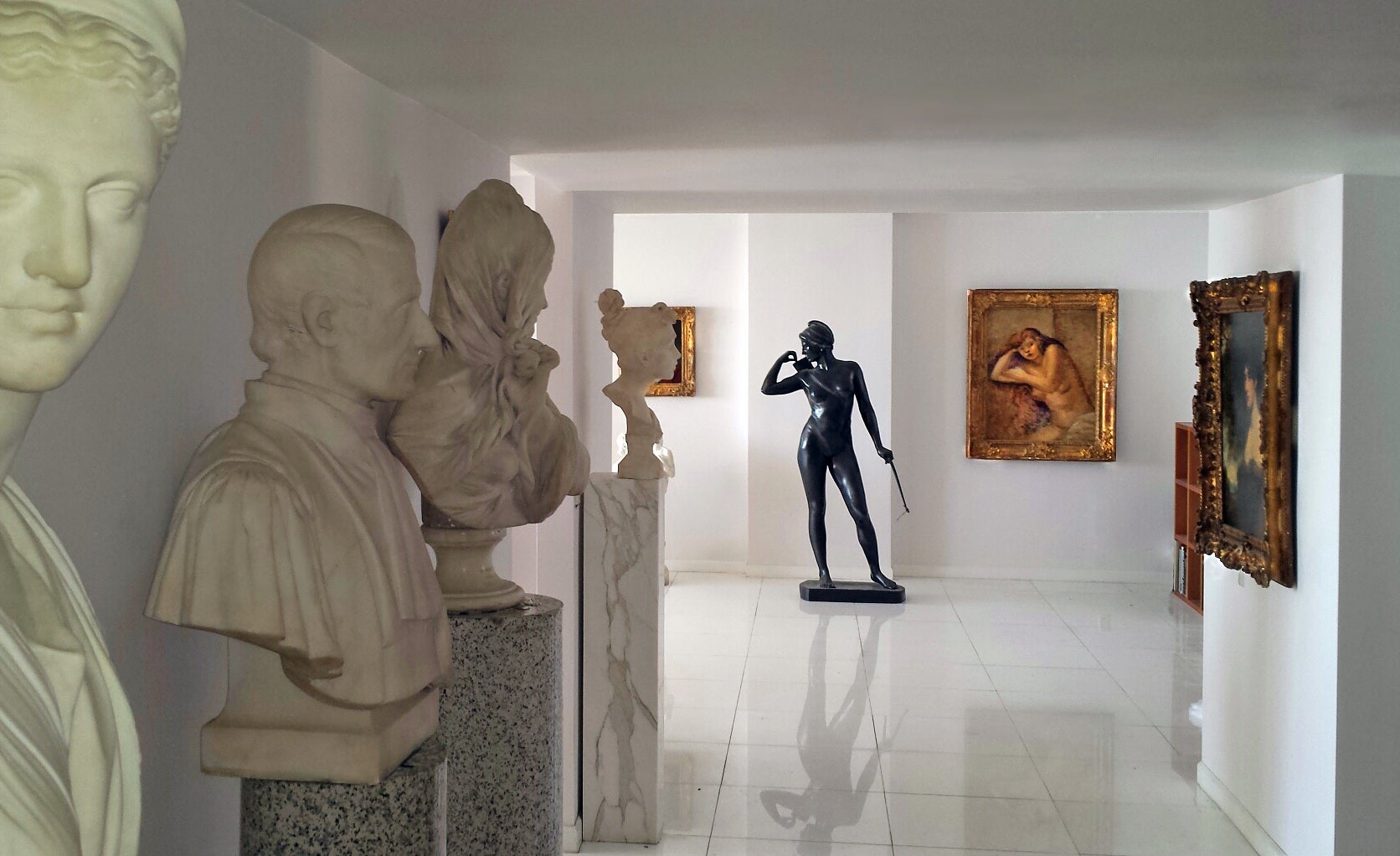
About the Seller
4.9
Gold Seller
Premium sellers maintaining a 4.3+ rating and 24-hour response times
Established in 2005
1stDibs seller since 2016
115 sales on 1stDibs
Typical response time: 1 hour
- ShippingRetrieving quote...Shipping from: Miami, FL
- Return Policy
Authenticity Guarantee
In the unlikely event there’s an issue with an item’s authenticity, contact us within 1 year for a full refund. DetailsMoney-Back Guarantee
If your item is not as described, is damaged in transit, or does not arrive, contact us within 7 days for a full refund. Details24-Hour Cancellation
You have a 24-hour grace period in which to reconsider your purchase, with no questions asked.Vetted Professional Sellers
Our world-class sellers must adhere to strict standards for service and quality, maintaining the integrity of our listings.Price-Match Guarantee
If you find that a seller listed the same item for a lower price elsewhere, we’ll match it.Trusted Global Delivery
Our best-in-class carrier network provides specialized shipping options worldwide, including custom delivery.More From This Seller
View AllElegant Nude Woman in Dancing - Mid-Century Monochromatic
By Walter Charles Klett
Located in Miami, FL
Excellent Mid-century nude by famous illustrator/ artist Walter Charles Klett. The work is masterfully painted with a sound understanding of the basic academic principles guiding t...
Category
Mid-20th Century American Realist Nude Paintings
Materials
Masonite, Oil
Rubenesque nude woman . full figure Nude Regionalism - "Hilda Nellis"
By John Steuart Curry
Located in Miami, FL
Plump, fleshy, or a voluptuous nude - you describe it as you see it.
Signed, titled, and dated lower left: John Steuart Curry / 1934 "Hilda Nellis".
The present work depicts a natur...
Category
1930s American Realist Figurative Paintings
Materials
Oil
Museum Quality, Nude with Pink Towel
By Abraham Walkowitz
Located in Miami, FL
Walkowitz creates a powerful composition with the tightly cropped nude figure pushed up-close to the viewer and occupying half of the picture plane. Smaller figures lead the eye back...
Category
1920s Modern Nude Paintings
Materials
Oil
Portrait of an Elegant Young Woman in Warm Grays and Soft Ochers
By Leon Kroll
Located in Miami, FL
Leon Kroll was above all an academician. To him "abstract art was merely the beginning of a picture. Structurally, "Portrait of a Young Woman recalls some of the portraits from the ...
Category
1930s Academic Portrait Paintings
Materials
Canvas, Oil
Nude Man In Bathing Suit, Male Nude in Speedo, Gay Art, Sex appeal
Located in Miami, FL
A handsome and fit young man with an introspective gaze is depicted in a Speedo Bathing suit as he sits against a tropical lake. The work is unframed and in fair to poor condition but has soul and sex appeal to it.
Louise Schacht...
Category
1930s Naturalistic Nude Paintings
Materials
Canvas, Oil
Nude Girl, Polynesian Girl Tahiti, Annabella
By Millard Sheets
Located in Miami, FL
In some instances, a painting will look significantly much better in person than it does digitize. This is one instance. In-person, this painting will knock your socks off. It is...
Category
1940s Post-Impressionist Nude Paintings
Materials
Canvas, Oil
You May Also Like
Female Bather (Nude Women)
Located in Wilton Manors, FL
Ann Brockman (1895–1943) was an American artist who achieved success as a figurative painter following a successful career as an illustrator. Born in California, she spent her childhood in the American Far West and, upon marrying the artist William C. McNulty, relocated to Manhattan at the age of 18 in 1914. She took classes at the Art Students League where her teachers included two realist artists of the Ashcan School, George Luks and John Sloan. Her career as an illustrator began in 1919 with cover art for four issues of a fiction monthly called Live Stories. She continued providing cover art and illustrations for popular magazines and books until 1930 when she transitioned from illustrator to professional artist. From that year until her death in 1943, she took part regularly in group and solo exhibitions, receiving a growing amount of critical recognition and praise. In 1939 she told an interviewer that making money as an illustrator was so easy that it "almost spoiled [her] chances of ever being an artist."[1] In reviewing a solo exhibition of her work in 1939, the artist and critic A.Z Kruse wrote: "She paints and composes with a thorough understanding of form and without the slightest hesitancy about anatomical structure. Add to this a magnificent sense of proportion, and impeccable feeling for color and an unmistakable knowledge of what it takes to balance the elements of good pictorial composition and you have a typical Ann Brockman canvas."[2]
Early life and training
Brockman was born in Northern California in 1895 and spent much of her youth in nearby Oregon, Washington, and Utah.[1][3] She met the artist William C. McNulty in Seattle where he was employed as an editorial cartoonist. They married in March 1914 and promptly moved to Manhattan where he worked as a freelance illustrator.[4][5] At the time of their marriage, Brockman was 18 years old.[6] Over the next few years, her career generally followed that path that her husband had previously taken. His art training had been at the Art Students League beginning in 1908; she began her training there after moving to New York in 1914.[1] After an early career as an editorial cartoonist, he freelanced as a magazine and book illustrator beginning in 1914; she began her career as a magazine and book illustrator in 1919.[7] He embarked on a teaching career in the early 1930s and not long after, she began giving art instruction.[8][9] While they both adhered to the realist tradition in art, their usual subjects were different. His prominently depicted urban cityscapes in the social realist whereas hers generally focused on rural landscapes. He was best known for his etchings and she for her oils and watercolors.[8][10]
Brockman returned to the Art Students League in 1926 to take individual instruction for a month at a time from George Luks and John Sloan.[1] Despite their help, one critic said McNulty's "sympathetic encouragement and guidance" was more important to her development as a professional artist.[11]
Career in art
In the course of her career as illustrator, Brockman would sometimes paint portraits of celebrities before drawing them, as for example in 1923 when she painted the French actress Andrée Lafayette who had traveled to New York to play title role in a film called Trilby.[12] She would also sometimes accept commissions to make portrait paintings and in 1929 painted two Scottish terriers on one such commission.[13] During this time, she also produced landscapes. In 1924 she displayed a New England village street scene painting in the Second Annual Exhibition of Paintings, Watercolors, and Drawings in the J. Wanamaker Gallery of Modern Decorative Art.[14] Available sources show no further exhibitions until in 1930 a critic for the Boston Globe described one of her portraits as "well done" in a review of a Rockport Art Association exhibition held that summer.[15]
Between 1931 and her death in 1943, Brockman participated in over thirty group exhibitions and five solos.[note 1] Her paintings appeared in shows of the artists' associations to which she belonged, including the Rockport Art Association, Salons of America, Society of Independent Artists, and National Association of Women Painters and Sculptors.[17][19]Between 1932 and 1935, her paintings appeared frequently in New York's Macbeth Gallery.[20][23][25][27] She won an award for a painting she showed at the Art Institute of Chicago in 1940.[41] In 1942, the Whitney Museum bought one of the paintings she showed in its Biennial of that year.[10] Critical praise for her work steadily increased during the decade that ended with her untimely death in 1943. In 1932, her painting called "The Camera Man" was called "a clever piece of illustration."[21] Three years later, a painting called "Small Town" gave a critic "the impression of freshness, honesty, and skill".[29] In 1938, a critic described her "Folly Cove" as "masterful" and said "Pigeon Hill Picnic" was "sustained by excellence of execution".[48] At that time, Howard Devree of the New York Times saw "evidence of gathering powers" in her work and wrote "she imparts a dramatic feeling to landscape. She even manages this time to do trees touched by Autumn tints without calendar effect, which is no small praise."[51] Three years later, a Times critic reported Brockman had "set herself a new high" in the watercolors she presented,[52] and another critic said the gallery where she was showing had not "for some time" shown "so outstanding a solo exhibitor as Ann Brockman."[2] Shortly before her death, a critic for Art News maintained that she was "one of America's most talented women painters".[46]
After she had died, a critic said Brockman's paintings "displayed real power", adding that she was "highly rated among the nation's professional artists" and was known to give "aid and encouragement, always with a smile," both artists and to her students.[10] in reviewing the memorial exhibition at the Kraushaar Galleries held in 1945, reviewers wrote about the strength and vibrancy of her personality, the quality of her painting ("every bit as good, possibly better than people had thought"),[53] called her "one of the best of our twentieth century women painters", and credited "her sense of the vividness of life" as a contributor to "the unusual breadth that is so characteristic of her work.[11] One noted that her work was "widely recognized throughout the country" and could be found in the collections of prominent museums, including the Metropolitan Museum of Art, the Whitney Museum of American Art, and the Art Institute of Chicago.[54] Writing in the Times, Devree wrote, "even those who had followed the steady growth of this artist for more than a decade, each successive show being at once an evidence of new achievement and an augury of still better work to come, may well be surprised at the combined impact of the selected paintings in the present showing,"[55] and writing in the Brooklyn Daily Eagle, A.Z Kruse said she had made "extraorginary accomplishments", painted with "inordinate distinction" showing a "lyrical majesty," and possessed "a keen esthetic sense which did not deviate from truth."[54]
Artistic style
(1) Ann Brockman, undated drawing, black chalk on paper, 18 x 22 inches
(2) Ann Brockman, High School Picnic, about 1935, oil on canvas, 34 1/4 x 44 1/4 inches
(3) Ann Brockman, untitled landscape, about 1943, watercolor and pencil on paper, 15 1/4 x 22 1/2 inches
(4) Ann Brockman, North Coast, undated watercolor, 21 1/2 x 30 inches
(5) Ann Brockman, On the Beach, 1942, watercolor on paper, 16 1/2 x 20 inches
(6) Ann Brockman, Lot's Wife, 1942, oil on canvas, 46 x 35 inches
(7) Ann Brockman, New York Harbor, 1934, watercolor on paper, 13 1/2 x 19 1/4 inches
(8) Ann Brockman, Youth, 1942, oil on board, 13 1/2 x 11 1/2 inches
Brockman was a figurative painter whose main subjects were rural landscapes and small-town and coastal scenes. She worked in oils and watercolors, becoming better known for the latter late in her career. Most of her paintings were relatively small. Although she made figure pieces infrequently, the nudes and circus and Biblical scenes she painted were seen to be among her best works. In 1938, Howard Devree wrote: "Her gray-day marines and coast scenes are familiar to gallery goers and are favorites with her fellow artists. Her figure pieces have attained a sculptural quality without losing warmth or taking on stiffness. One spirited circus incident of equestriennes about to enter the big tent compares not unfavorably with many of the similar pictures by a long line of painters who have been fascinated by the theme. She imparts a dramatic feeling to landscape. She even manages this time to do trees touched by Autumn tints without calendar effect, which is no small praise."[51] Similarly, a critic for Art Digest wrote that year: "Fluently and virilely painted, [her] canvases suggest a close affinity between nature and humans. The artist takes her subjects out in the open where they may picnic or bathe with space and air about them. A fast tempo is felt in the compositions of restless horses and nimble entertainers busily alert for the coming performance. Miss Brockman is also interested in portraying frightened groups of people, hurrying to safety or standing half-clad in the lowering storm light."[56]
Her palette ranged from vivid colors in bright sunlight to somber ones in the overcast skies of stormy weather. Of the former, one critic spoke of the rich colors and "sun-drenched rocks" of her coastal scenes and another of her "summery landscapes of coves and picnics."[11][50] Of the latter, Howard Devree said she "painted so many moody Maine coast vignettes of lowering skies and uneasy seas that artists have been heard to refer to an effect as 'an Ann Brockman day'".[57]
Brockman's handling of Biblical subjects can be seen in the oil called "Lot's Wife", shown above, Image No. 6. Her watercolor called "On the Beach" and her oil portrait called "Youth" may both indicate the "sculptural quality" that Devree said was typical of her figure pieces (Image No. 8, above).
An example of Brockman's bright palette in a typical summer theme is the oil painting called "High School Picnic" shown above, Image No. 2. Next to it is a painting, an untitled landscape of about 1943 whose medium, watercolor on paper, shows off the sunny palette she often used (Image No. 3).
Among the darkest of her works was an untitled 1942 drawing she made in black chalk (shown above, Image No. 1). In a book called Drawings by American Artists (1947), the artist and art editor Norman Kent noted that this study influenced her painting through its use of "forms" that were "elastic" and suggested "color". He said its "massing of dark and light" created "a definite mood" that was "impressionistic" and had "the strength of a man's work".[58] Brockman's undated watercolor called "North Coast" (shown above, Image No. 4) is an example of the paintings to which Kent referred.
Illustrator
(9) Ann Brockman, cover, March 12, 1917, Every Week magazine
(10) Illustration of an article, "The Taking of a Salient" by Henry Russell...
Category
1930s American Impressionist Nude Paintings
Materials
Oil
$1,200 Sale Price
20% Off
Vintage Paris School Nude Female Bathers Double Sided Impressionist Oil Painting
Located in Buffalo, NY
Antique impressionist nude woman portrait oil painting. Oil on canvas. Framed.
Category
1950s Impressionist Nude Paintings
Materials
Canvas, Oil
$716 Sale Price
20% Off
"Nude, " Arnold Blanch, Woodstock School, WPA, Figurative
By Arnold Blanch
Located in New York, NY
Arnold Blanch
Nude
Signed lower right
Oil on board
20 x 16 inches
Provenance:
G. David Thompson Collection, Pittsburgh
Private Collection, New York
Bo...
Category
1930s Realist Nude Paintings
Materials
Oil, Board
$1,240 Sale Price
50% Off
Nude Portrait of a Lady - 1930's French Post-Impressionist Oil Canvas Painting
Located in Sevenoaks, GB
A beautiful large 1930's French post-impressionist oil on canvas nude portrait of a lady in the artist's studio, by Bertrand Py.
Excellent quality and very good condition portrait ...
Category
1930s Post-Impressionist Portrait Paintings
Materials
Canvas, Oil
Oil painting on Canvas, Bathing Nude By Maria Szantho
By Maria Szantho
Located in Gavere, BE
Oil painting on Canvas, Bathing Nude By Maria Szantho
Nice and large painting " portrait of a nude Gipsy girl " painted by the female artist Maria Szantho (1897 - 1998) Hungarian sc...
Category
1960s Realist Nude Paintings
Materials
Canvas, Oil
Nude Woman - Mid 20th Century Nude Still Life Oil Painting by Arnold Beauvais
By Arnold Beauvais
Located in Watford, Hertfordshire
Arnold Beauvais (1886-1984)
Arnold Victor Beauvais was born in Lewisham on 13 April 1886, son of a French father, the artist Charles Henri Beauvais, and an English mother, Anne, née Corfield. He trained in his father's commercial art studio during the day, working on lithographic printing and poster design, and took night classes at the Bolt Court Art School in Fleet Street.
In 1903 his father returned to his home town of Marseille and set up a commercial art studio. Arnold studied in Paris for sixteen months before joining his father in Marseille. Charles died...
Category
1940s Post-Impressionist Nude Paintings
Materials
Canvas, Oil
